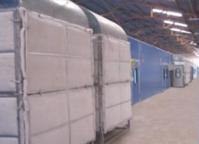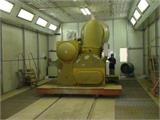Search Encyclopedia Spray Booth
Painting Room Abstract
A painting room, as the name suggests, is a space where objects to be painted are filtered and sprayed with paint. It is also known as a paint-baking room. The painting room provides a dedicated environment for painting operations, meeting requirements for temperature, humidity, lighting, and air cleanliness necessary for such tasks. It restricts and processes the paint mist and organic exhaust gases produced during spraying, ensuring their safe emission, making it an environmentally friendly painting device.
Contents: 123456
A painting room, as the name implies, is a place where objects are filtered and sprayed with paint inside a room, now also referred to as a paint-baking room.
Traditional painting was done outdoors using a spray nozzle on items (cars, furniture, etc.), but this method often leads to reduced painting quality for large objects. For example, during spraying, dust from the air mixes with the paint, lowering the painting quality; there's uncertainty in wasting paint, and the painting area becomes very dirty. For workers, they not only get dirty but also inhale large amounts of paint mist, which is harmful to their health.
Later, people wanted to confine painting within a certain range, thus creating the earliest type of painting room—the exhaust-type painting room. In China, the first painting rooms appeared in the Chengdu region in the early 1990s.
1) Divided by airflow direction into three categories:
- Cross-flow painting room: Air flows from one end of the room to the other. This model has low cost and is easy to install. However, the mist moves along the side of the object being painted, and the mist cannot be removed from around the operator's face, resulting in an unsatisfactory working environment.
- Side-downflow painting room: Air enters the painting room through a filter on the ceiling and exits through the side walls. This is a mid-priced painting room. Since the mist is far from the object itself and can be removed from around the operator, both the painting effect and the working environment are more ideal.
- Fully downflow painting room: Represents the most advanced technology today. Air enters through the ceiling and is discharged outside through trenches or basements. This exhaust method results in a cleaner painting process and a safer working environment. However, it has high costs and occupies a large space.
2) Classified by heating method: diesel painting room, electric heating painting room, steam heating painting room, infrared baking room, waste engine oil painting room, etc.
3) Classified by paint mist treatment method: divided into dry-type painting room and wet-type painting room (water treatment). The most commonly used painting room employs dry treatment, so the filtration system (mainly referring to primary and secondary filter cottons) needs regular inspection and replacement. Otherwise, it could either affect the quality of baking or even cause a fire. With further development in science and technology, methods for handling excess paint mist have become increasingly advanced. Many high-end cars now use water-treated painting rooms, dissolving the excess paint mist in water, representing significant progress in paint mist treatment.
The three keys to an exhaust-type painting room are:
1. Ventilation - key to how the exhaust-type painting room works
2. Filtration - filtering small particles in the air
3. Exhaust - discharging waste air and introducing new air (outdoor air) - painting room door filter cloth - painting table - using painting equipment for splashing painting - exhaust fan (discharging generated paint mist)
Weaknesses still exist:
1. Filter cloth is easily damaged, allowing dust to enter
2. Likely to introduce unclean outdoor air
3. Not environmentally friendly, wastes paint
4. Requires frequent cleaning and regular removal of dirt from the filter cloth
A new type of painting room - the fully pressurized painting room - has already been widely applied in China's furniture industry. The basic principle of the fully pressurized painting room is the same as that of the exhaust-type painting room, but it utilizes the directivity of pressure, applying pressure vertically from top to bottom for more precise painting. In terms of hardware, it features a main control room, replacing filter cloth with "multi-layer filter cotton" for higher air cleanliness; uses infrared bake lamps to save drying time; and employs water curtains when discharging excess paint mist for greater environmental friendliness. As a result, the rework rate is almost zero, saving paint and improving work efficiency. Due to the use of infrared bake lamps, people now also call it a paint-baking room.
Background Analysis: Amid continuous losses in many global automobile markets, China's automobile market stands out, achieving remarkable results. This provides a big stage for the development of China's auto maintenance market. Over the past decade, despite major fluctuations, rises, and accelerations in China's auto maintenance market, everyone remains highly enthusiastic and confident about themselves, their companies, and the market. With the continuous increase in domestic automobile totals, the demand for painting rooms continues to grow, especially for large special-shaped painting rooms. High-quality, high-demand specialized paint-baking rooms are taking up an increasing share of the market. An industry insider described at an exhibition that employees' income is extremely high, yet they still complain: having money but no time to spend. The market for large special-shaped painting rooms is "crazy," specialized painting rooms are "hot," and ordinary painting rooms sell even more "powerfully." Meanwhile, manufacturers are taking advantage of the market's rapid development to re-plan their own development and positioning, increasing attention to various aspects of paint-baking rooms.
Principles and Structure of Painting Rooms: The entire paint-baking room is of modular construction, with the body made of mother-child plug-insulated spray-plastic wall panels, providing good sealing and thermal insulation performance. Aluminum alloy edges surround the doors, with observation windows in the center to monitor internal dynamics at any time. Work doors are installed on the side of the housing for staff access. High-quality stainless steel heat exchangers ensure high heat exchange efficiency and long service life. Imported, low-noise, high-airflow fans ensure perfect painting results. The painting room provides: (1) a clean working environment; (2) full collection of paint mist. The configuration of the painting room varies according to the size, shape, weight, and production guidelines of the workpiece, including open or closed types, continuous or intermittent types, rotating or fixed workpieces, single-side or double-side spraying. Recently, oil curtain painting rooms and bottom-spraying rooms have also developed. Structurally, it should include: air supply filtration systems, workpiece suspension (conveyance, rotation) devices, water curtain systems, water washing systems, exhaust systems, water tanks, lighting devices, and housing.
Principle of Paint Mist Recovery: Paint mist recovery can be divided into two parts: First, during the spraying of workpieces, paint mist collides and mixes with the water curtain, part of which dissolves in the water curtain and falls into the water tank. Second, the paint mist not dissolved in the water curtain enters the water washing chamber through the gap at the bottom of the water curtain board, mixing fully with the water mist sprayed by the atomizing nozzles. After gas-water separation and sedimentation, it flows into the water tank. Coagulants are regularly added to the water tank to form paint sludge.
Factors to Consider When Purchasing a Paint-Baking Room:
① Brightness: The brightness inside the paint-baking room should reach 800-1000 lux, and lights close to D65 light sources should be used, while the interior walls should be matte white;
② Airflow;
③ Filtration effect: This depends on the type of top cotton used in the paint-baking room. Generally, repair shops use EU5 and EU6 models. During use, a sun lamp can be used to illuminate the upper part of the room, with less than 5 extremely fine dust particles per square meter;
④ Wall sealing effect: The paint-baking room must be sealed, and there should be no accumulation of paint dust at the seams;
⑤ Positive pressure assurance: The air intake volume should be slightly greater than the exhaust volume, keeping the paint-baking room under positive pressure;
⑥ Sealing effect of the heating system: There should be good sealing around the burner and chimney, with no residual oil ash after combustion;
⑦ Heating speed: The time it takes for the paint-baking room to rise from 20°C to 60°C is approximately 10-15 minutes. Note that some paint-baking room thermometers may be inaccurate, so the temperature measurement should be based on the metal body temperature inside the paint-baking room. If the selected paint-baking room meets these conditions, it would be considered an ideal paint-baking room. However, over time, issues such as poor quality, excessive dust inside the room, poor construction effects, and inadequate lighting may arise. These problems can be avoided if the paint-baking room is properly used and maintained. Below, we simply introduce the usage precautions and daily maintenance techniques for automotive paint-baking rooms, hoping to reduce unnecessary wear and lower safety hazards.
1. Determine a reasonable configuration form.
2. Determine a reasonable average horizontal airflow velocity for the paint booth.
3. Reasonably match the supply and exhaust systems to ensure slight positive pressure inside the paint booth.
4. The water curtain thickness should be uniform, paying attention to the structure of the water tank and the distribution of water supply pipes.
5. The distance between the bottom of the water curtain panel and the liquid surface of the water tank should be appropriate.
6. The fogging spray nozzles and pipelines should be easy to dismantle, replace, and clean.
7. The gas-water separation and settling should be sufficient and easy to clean.
Standards:
1)
2)
3) Guangdong Province "Air Pollution Emission Limit" (DB44/27-2001)
4) "Norms for Installation, Construction, and Acceptance of Mechanical Equipment" (TJ231-28)
5) "Norms for Construction and Acceptance of Industrial Pipeline Engineering" (GBJ235-82)
6) "Design Norms for Low Voltage Distribution Equipment and Circuit" (GBJ54-83)
Painting rooms are usually used for spraying and baking paint. Therefore, the most accurate description of a paint-baking room should be "spray-bake room," widely used in the automotive, machinery, hardware, furniture, and chemical industries for surface painting and baking operations. Based on the airflow direction of the paint-baking room, it can be divided into the following three categories: cross-flow paint-baking room; side-downflow paint-baking room; full-downflow paint-baking room. Cross-flow paint-baking room: Air flows from one end of the room to the other. This model has low cost and is easy to install. However, the mist moves along the side of the vehicle, and the mist cannot be removed from around the operator's face, resulting in an unsatisfactory working environment.
Side-downflow paint-baking room: Air enters the paint-baking room through a filter on the ceiling and exits through the side walls. This is a mid-priced paint-baking room. Since the mist is far from the vehicle, and it can be removed from around the operator, both the painting effect and the working environment are more ideal.
Full-downflow paint-baking room: Represents the most advanced technology today. Air enters through the ceiling and is discharged outside through trenches or basements. This exhaust method results in a cleaner painting process and a safer working environment. However, it has high costs and occupies a large space.
Automobile painting room, furniture painting room, environmental protection spray-bake room. Environmental protection spray-bake room includes a painting room and a bake room. Its characteristics are: the painting room and bake room have air inlet channels and air distribution plates at the top, the bottom of the painting room has a circulating water pool, the circulating water pool has an iron grille, and one side of the circulating water pool connects to the exhaust channel. It solves the problem of existing products having poor working environments, leading to low-quality paint products and serious harm to the painter's health and the environment. This novel environmental protection spray-bake room has the advantages of efficiency, environmental protection, and energy saving.
During spraying, external air passes through a primary filter net and is delivered to the roof by a fan, then goes through a secondary filtration and purification process before entering the room. The air inside the room adopts a full-descending flow pattern, moving downward at ≥0.3m/s, ensuring that the paint mist particles cannot remain suspended in the air but instead pass directly through the bottom filter device and are discharged outside the room. This continuous cycle ensures that the air cleanliness inside the painting room reaches above 98% during spraying. Moreover, the supplied air has a certain pressure, ensuring that indoor dust does not infiltrate the spray-bake room, contaminating the workpiece surface, thereby maximizing the quality of the paint job. During baking, the wind door is adjusted to the baking position, and the hot air circulates, quickly raising the room temperature to the preset drying temperature (≤80°C). The fan draws in fresh external air, which undergoes initial filtration, exchanges heat with the heat converter, and is sent to the air chamber at the top of the paint-bake room. After undergoing a second filtration and purification, the hot air, through the inner circulation action of the wind door, absorbs a small amount of fresh air while continuing to utilize most of the heated air, gradually raising the temperature inside the paint-bake room. When the temperature reaches the set temperature, the burner automatically stops; when the temperature drops to the set temperature, the fan and burner automatically turn on again, maintaining a relatively constant temperature inside the paint-bake room. Finally, when the baking time reaches the set time, the paint-bake room automatically shuts off, ending the baking process.
1. Before spraying, check if the spraying air pressure is normal and ensure the filtration system is clean.
2. Check the air compressor and oil-water micro-dust separator to keep the spray hose clean.
3. Store spray guns, spray hoses, and paint cans in clean places.
4. All procedures before spraying, except for dust removal using blow guns and sticky cloths, should be completed outside the paint-bake room.
5. Only spraying and baking operations should take place inside the paint-bake room, and the room door should only be opened when vehicles enter or exit. When opening the door, activate the air circulation system to produce positive pressure, ensuring that dust outside does not enter the room.
6. Wear designated spray suits and safety protective equipment to operate inside the paint-bake room.
7. During baking operations, remove all flammable items from the paint-bake room.
8. Unnecessary personnel should not enter the paint-bake room. My evaluation: Entry Evaluation: 3 points (evaluated by 11 people).




